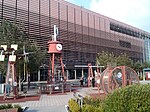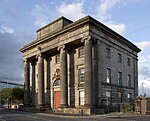Eastside City Park
Linear parksParks and open spaces in Birmingham, West MidlandsUrban public parks in the United Kingdom

Eastside City Park is a 6.75 acre (2.73 ha) urban park located in the Eastside district of Birmingham City Centre. Designed by architects Patel taylor with landscape architect Allain Provost, the park was opened to the public on 5 December 2012 at a cost of £11.75 million. Lining the frontage of Millennium Point, the park provides 14,300 square metres of landscaped green space, 310 trees, a 110 metres (360 ft) canal water feature and a public square incorporating 21 jet fountains.
Excerpt from the Wikipedia article Eastside City Park (License: CC BY-SA 3.0, Authors, Images).Eastside City Park
Fox Street, Birmingham Digbeth
Geographical coordinates (GPS) Address Nearby Places Show on map
Geographical coordinates (GPS)
| Latitude | Longitude |
|---|---|
| N 52.482 ° | E -1.8877 ° |
Address
Fox Street
B5 5AE Birmingham, Digbeth
England, United Kingdom
Open on Google Maps









